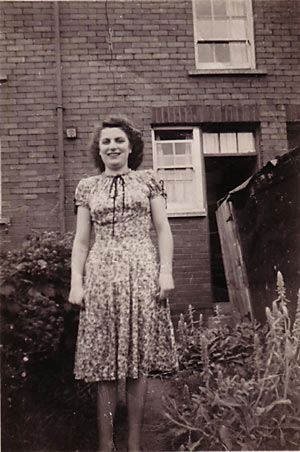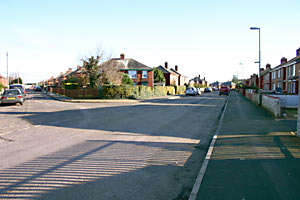
Exeter Stories
Exeter folk and friends in their own words - 1890's to the 1990's │ << Previous story │ Next story >> │
Also see Exeter blitz
Sylvia Hart - Exeter in 1939
"At 9 years of age I remember being in my grandmothers room behind her shop (18 Sun Street, Exeter). It was quite a family gathering and a lot of worried talk about a war being threatened between our country and Germany. The worry being my boy cousins would all get called up for military service.
A few days later it was announced war was declared. At this time it didn't mean much to me. First we were issued with ration books for food, coupons for our new clothes and identity cards. My no. was WDCG 179.3. My sweet ration didn't hurt much as my mother ate very few and my father had none.
The next thing, we all had to be fitted with gas masks and we had to take them everywhere with us. Windows had to have black out curtains - no lights were allowed to show from any house in the dark. Street lights, cars and cycles all had shields fitted to stop lights showing to any aircraft in the sky. Men too old for war service either joined the home guard or became A.R.P. wardens. Women were called into the forces or war work. My sister had to go to Wippells in Buller Road making parachutes first, before being conscripted away to a munitions factory called Hoffmans in Stonehouse, Glos. Travel was restricted so like a lot of young women they didn't come home very often.
Evacuees arrived from London and Bristol. We had two boys at first from Fulham. I ended up marrying one of them in 1951.
Foreign Troops
We saw a lot of service people. Topsham Barracks had our own servicemen off various regiments. Higher Barracks was the same. The Americans came over and built a naval supply depot at Countess Wear - it ended up right back to Rydon Lane.
Exeter Airport was used by British, Polish and Czech airmen both flying and ground crews. Night times you would hear the planes loaded with bombs for the raids over Germany. Later you would hear them returning, the Polish and Czechs. If they were shot up on missions, they would rather try to make it back to base than bail out of their craft over enemy territory. At odd times you would hear an explosion and you knew some poor souls didn't make it. I think the Norwegian Air force were stationed at Winkleigh. The coloured American Army had a camp at Ashburton. White American personnel were separated and had camps around Exeter to avoid trouble between them.
Up to I think early 1942 or late 1941 Exeter was a beautiful city with a lot of character. It saw a lot of foreign servicemen coming and going.
The Start of the Blitz
But then the bombing started. My father was in the demolition squad based near the Council Yard in Exe Island. The depot windows at the back looked over the slaughter house in Tudor Street. Their first call out was to St Loyes. A landmine had been dropped killing two men and two children. I remember my father saying one of the men worked for the Admiralty and when they picked him up his watch was still going. The children were killed by the blast.
Then sometime later we had a daylight raid. Bombs were dropped but I cannot now give an exact location. I do remember Mr Bidgood, the undertaker in Holloway Street having the bodies of some airmen in his chapel of rest and they were picked up in the street nearby. I think the airmen had been killed at Exeter Airport.
I haven’t mentioned the sirens - this was a warning of planes about. You were then alert until the all clear siren went but there were times when bombs dropped before the sirens.
May 1942
And then May 4th 1942, the blitz - what a dreadful night.
We hadn't had our Anderson Shelter delivered so we went to a friends house at no 13 Hazel Road as the siren sounded. My father had to go to his depot in Exe Island. My sister (who was home at the time) and I were sent up the road to our friends (mother would stay to see father off!). The sky was alight with flares coming down as we got half way along the path, a bomb dropped in Briar Crescent (see note to the side). A Mr Rookes was killed there. It really was a terrifying night.
We didn't see my father for four days. Exeter was not Exeter anymore. You could stand by the Guildhall and see the Odeon Cinema. Sidwell Street. South Street, Sun Street through to the top of Fore Street didn't exist. It was just flattened - the Guildhall and that part of the High Street from North Street still stood. Boots corner of Queen Street, Express and Echo Offices, Colsons (now Dingles) and St Stephens Church stood but beyond that everything had been demolished.
My father was in the mortuary squad. Exeter Central School was used as a mortuary. There was lot of Exonians killed and injured. I remember my father coming home looking at me and tough man that he was burst into tears. He told my mother that having gone through the Somme, Ypres and through out the First World War it was picking up the bodies of women and children he found hard. The majority of the people killed were buried in Higher Cemetery. Some people that were blown to bits were taken and buried at midnight again in the Higher Cemetery.
Lists of the dead and injured were posted on the railings of Southernhay West. It really was a dreadful time. I really wouldn’t want any of my family to ever experience such an event.
But if good can come out of bad, people in general cared for each other. There really was a unity that you don’t see today.
Rationing
Coupons - you had 24 to last (I think) 6 months.
A ladies long fully lined coat was - 18 coupons
Half lined -15 coupons
Shoes - 7 coupons sandals 5 coupons
Dress - 7 coupons 2 piece 10 coupons
Cami-knicks - 3 coupons
Stocking - 1 coupon - girls painted their legs
Bras - 1 coupon
Rations - you could buy tins of dried egg, Spam with enough fat around to make the pastry. Rabbits, fish, sausage were coupon free and then of course there was the black market but to get some you really had to pay."
© 2005 Sylvia Hart / David Cornforth
 A 15 year old Sylvia Hart outside her home in Laburnam Road
A 15 year old Sylvia Hart outside her home in Laburnam Road
Briar Crescent bomb
This bomb fell at 0200 on 4th May 1942. The report said:
'Burnthouse Lane. Fell 12ft. behind houses of Briar Crescent and Laburnam Rd. A6. B4. CO.D15. Water, Gas & Electric affected. Severe blast. Killed. 1 male.'
It went on to say that the bomb fell on clay ground and the crater measured 21 ft diameter by 3 ft deep. The bomb weighed 500 lb.
 Briar Crescent with Hawthorn Road on the left,
Briar Crescent with Hawthorn Road on the left,
│ Top of Page │